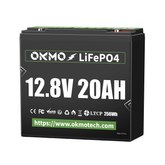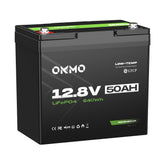About LiFePO4 Battery Life : Five Things You Must to Know

LiFePO4 (Lithium Iron Phosphate) batteries have become increasingly popular in recent years due to their high energy density, long cycle life, and excellent safety profile. Whether you're using them for renewable energy storage, electric vehicles, or portable power solutions, understanding the factors that affect their lifespan is crucial. Here are five key things you need to know about LiFePO4 battery life, including the importance of deep cycle performance, and why the OKMO LiFePO4 battery stands out with its impressive 4,000 - 15,000 deep cycles.

1. Depth of Discharge (DoD)
The Depth of Discharge (DoD) refers to how much of the battery's capacity is used before recharging. LiFePO4 batteries are known for their ability to handle deep discharges better than other lithium-ion chemistries. For example, while lead-acid batteries typically allow only 50% DoD to maximize lifespan, LiFePO4 batteries can often handle 80-90% DoD without significant degradation.
However, consistently discharging a LiFePO4 battery to its maximum DoD can still reduce its overall lifespan. To maximize longevity, it's recommended to keep the DoD between 20% and 80%. This practice ensures that the battery operates within a safe range, minimizing stress on its internal components.

2. Cycle Life and Deep Cycle Performance
Cycle life is one of the most critical factors in determining a battery's lifespan. A cycle is defined as one complete discharge and recharge of the battery. LiFePO4 batteries are renowned for their long cycle life, often exceeding 2,000 cycles even at high DoD levels.
Deep cycle performance is particularly important for applications like solar energy storage or electric vehicles, where the battery is regularly discharged and recharged. The OKMO LiFePO4 battery excels in this area, offering an impressive 4,000 to 15,000 deep cycles depending on usage conditions. This makes it an ideal choice for applications requiring frequent and deep discharges.

3. Temperature Management
Temperature plays a significant role in the lifespan of LiFePO4 batteries. While they are more thermally stable than other lithium-ion batteries, extreme temperatures can still affect their performance and longevity.
-
High Temperatures: Prolonged exposure to high temperatures (above 35°C or 95°F) can accelerate chemical reactions within the battery, leading to faster degradation.
-
Low Temperatures: Extremely low temperatures (below 0°C or 32°F) can reduce the battery's efficiency and capacity temporarily.
To maximize battery life, it's essential to operate LiFePO4 batteries within their recommended temperature range (typically 0°C to 45°C or 32°F to 113°F). Using a battery management system (BMS) that includes temperature monitoring can help protect the battery from thermal stress.

4. Charging and Discharging Rates
The rate at which a LiFePO4 battery is charged or discharged can also impact its lifespan. Fast charging or discharging at high currents generates heat and increases internal resistance, which can lead to faster degradation over time.
-
Optimal Charging Rate: Most LiFePO4 batteries perform best when charged at a rate of 0.5C to 1C (where 1C is the battery's capacity in ampere-hours). For example, a 100Ah battery should ideally be charged at 50A to 100A.
-
Discharging Rate: Similarly, discharging at moderate rates (e.g., 0.5C to 1C) is recommended to avoid excessive stress on the battery.
The OKMO LiFePO4 battery is designed to handle a wide range of charging and discharging rates, making it versatile for various applications while maintaining a long lifespan.

5. Battery Management System (BMS)
A high-quality Battery Management System (BMS) is essential for maximizing the lifespan of a LiFePO4 battery. The BMS monitors and controls key parameters such as voltage, current, and temperature to ensure safe and efficient operation.
-
Overcharge Protection: Prevents the battery from being charged beyond its maximum voltage, which can cause damage.
-
Over-Discharge Protection: Stops the battery from discharging below its minimum voltage, preserving its capacity.
-
Balancing: Ensures that all cells within the battery pack are charged and discharged evenly, preventing imbalances that can reduce overall lifespan.
The OKMO LiFePO4 battery comes equipped with an advanced BMS, providing comprehensive protection and ensuring optimal performance throughout its lifespan.
Why Choose OKMO LiFePO4 Battery?
When it comes to deep cycle performance and overall lifespan, the OKMO LiFePO4 battery stands out as a top choice. With an impressive 4,000 to 15,000 deep cycles, it offers unparalleled durability for applications requiring frequent and deep discharges. Its robust design, advanced BMS, and ability to operate efficiently across a wide range of conditions make it a reliable and long-lasting energy storage solution.
Whether you're powering a solar energy system, an electric vehicle, or a portable power station, the OKMO LiFePO4 battery delivers the performance and longevity you need. By understanding and optimizing the factors that affect battery life, you can ensure that your investment in OKMO LiFePO4 batteries pays off for years to come.

In conclusion, LiFePO4 batteries are a superior choice for applications requiring long cycle life and deep cycle performance. By managing factors such as depth of discharge, temperature, charging rates, and using a high-quality BMS, you can maximize their lifespan and efficiency. The OKMO LiFePO4 battery, with its exceptional deep cycle capabilities, is a standout option for anyone seeking a reliable and durable energy storage solution.











